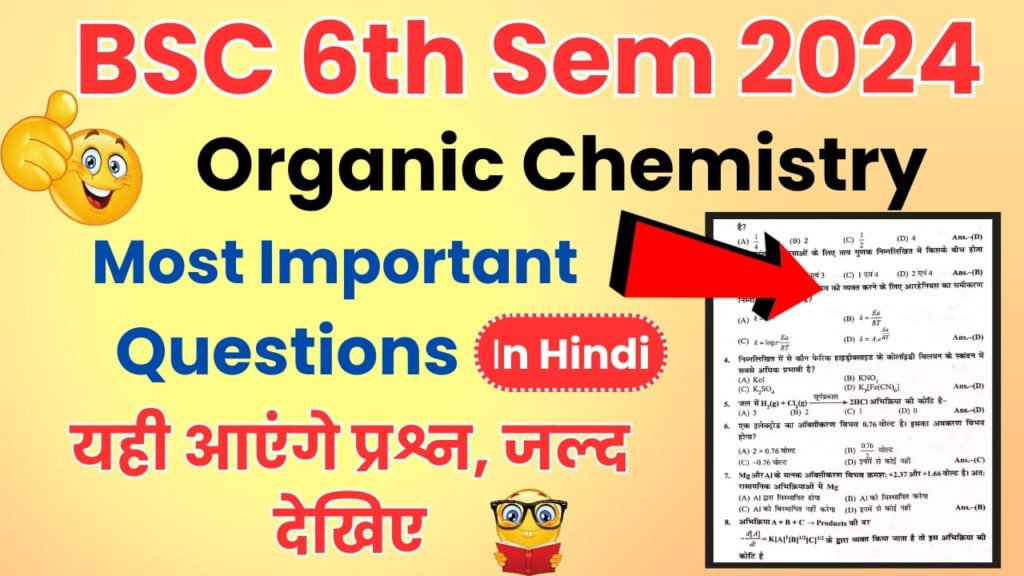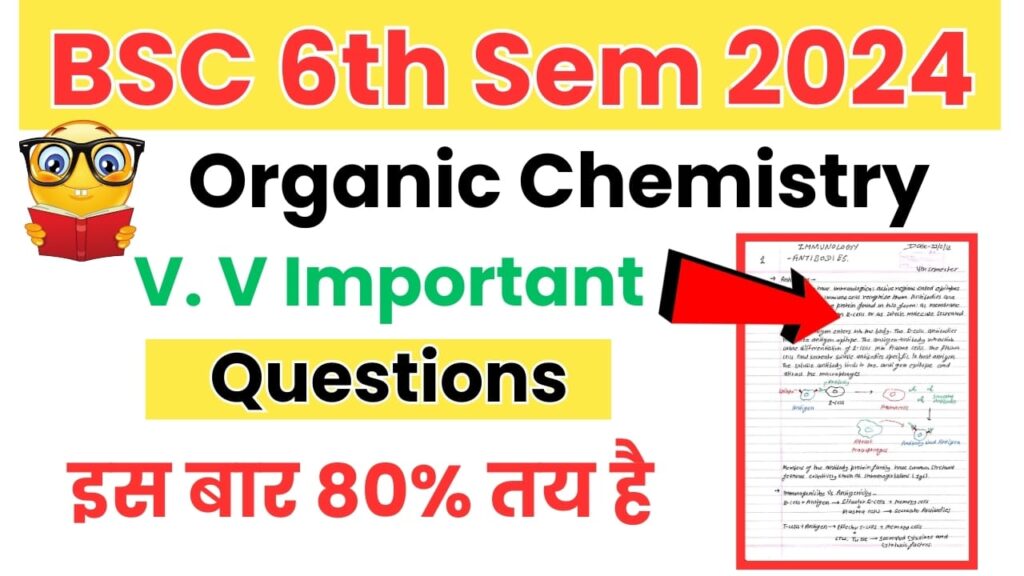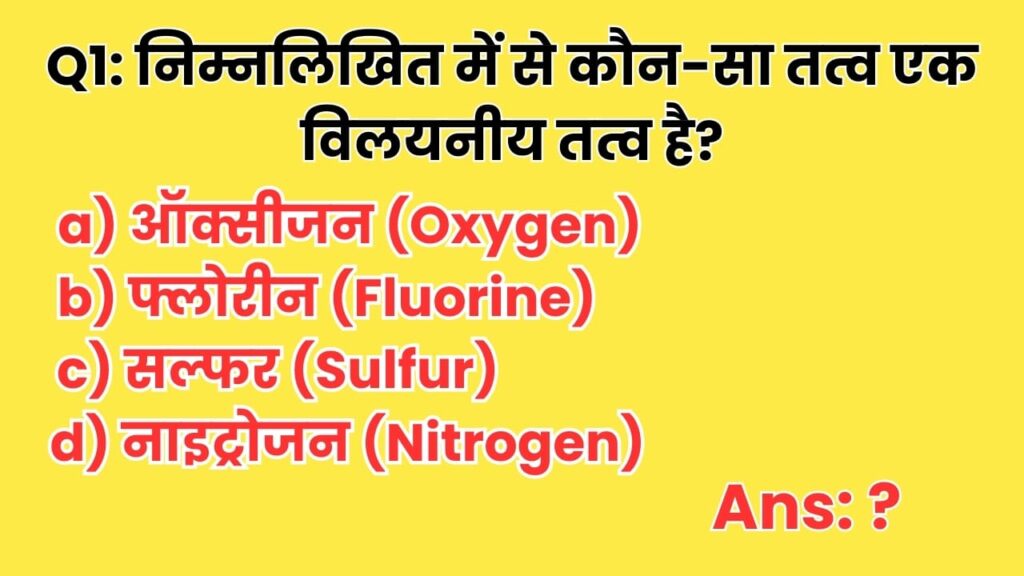नमस्कार साथियों क्या आप जानना चाहते है BSC 6th Semester Organic Chemistry Important Questions In Hindi 2024 के बारे में? दोस्तों आपका स्वागत है इस लेख में, हम आपको BSC 6th Semester Inorganic Chemistry Important Questions in Hindi के साथ BSC 6th Semester Organic Chemistry Syllabus और BSC 6th Semester inOrganic Chemistry Important Notes 2024 के बारे में भी बताएंगे।

जैसा कि आप जानते हैं Chemistry एक बहुत ही दिमाग लगाने वाला subject है, तो इस लेख में हमने BSC 6th Semester Organic Chemistry Important Questions In Hindi इकट्ठा किया है जो कि आपको पढ़ने में मदत करेंगे अगर आप इस लेख में बताए हुए organic Chemistry Important Questions को एक बार रट लेंगे तो आप समझ लो 60% syllabus cover हो जाएगा, तो BSC 6th Semester Organic Chemistry Important Questions In Hindi 2024 की पूरी सूची पढ़ने के लिए इस लेख को अंत तक जरूर पढ़ें ।
यह BSC 6th Semester Organic Chemistry Important Questions In Hindi 2024 के महत्वपूर्ण प्रश्न 2024 प्रतिष्ठित संस्थानों के अनुभवी शिक्षकों द्वारा तैयार किए गए हैं, इन प्रश्नों के पेपर में आने की अधिक संभावना है, इसलिए इन्हें अच्छी तरह से तैयार करें।
BSC 6th Semester Organic Chemistry Important Questions In Hindi

Q: पार्टिकल बोर्ड स्विचिंग (Particle Board Switching) का उपयोग किसके लिए किया जाता है?
a) प्रोटीन की विधुत विशेषता (Protein Electrophoresis)
b) प्रोटीन की संरचना (Protein Structure)
c) प्रोटीन की उत्पत्ति (Protein Synthesis)
d) प्रोटीन के परिणाम (Protein Effects)
Answer: a) प्रोटीन की विधुत विशेषता (Protein Electrophoresis)
Q: अल्डोहोल का सामान्य सूत्र क्या है?
a) R-OH
b) R-COOH
c) R-CHO
d) R-O-R’
Answer: a) R-OH
Q: जिगर के किस भाग में प्रमुखत: इमिनिक एसिड बनता है?
a) इमिनिक
b) अमिनिक
c) सुल्फहाइड्राइन
d) कार्बोनाइक
Answer: b) अमिनिक
Q: विभिन्न कार्बोक्सीलिक अम्लों में कौन-सा बैंकर अम्ल कहलाता है?
a) परफॉर्मिक अम्ल
b) ओक्सालिक अम्ल
c) ब्यूटेरिक अम्ल
d) अस्कोर्बिक अम्ल
Answer: b) ओक्सालिक अम्ल
Q: स्वाइस रोल्स किस विधुत आवेग के लिए प्रयुक्त होते हैं?
a) नाइट्रोजन जलवायु विधुत
b) सोल्यूबलिटी विधुत
c) प्रोटीन जलवायु विधुत
d) प्रोटीन एलेक्ट्रोफोरेसिस
Answer: d) प्रोटीन एलेक्ट्रोफोरेसिस

Q: अल्डोहोल किसके साथ एसिडिक उपस्थिति में धीमा अध्ययन करते हैं?
a) इसोटोप
b) कार्बोनेट
c) इसोमर
d) एस्टर
Answer: d) एस्टर
Q: कार्बोक्सीलिक अम्लों को सबसे अधिक क्या रूप से पहचाना जाता है?
a) कार्बोन धातु
b) ऑक्सीजन धातु
c) नाइट्रोजन धातु
d) हाइड्रोजन धातु
Answer: b) ऑक्सीजन धातु
Q: बेंजीन इसोसाइनाइट के रसायनिक सूत्र क्या है?
a) R-NO2
b) R-NH2
c) R-N2
d) R-NH-NH2
Answer: c) R-N2
Q1: परमाणु और अणु रासायनिक आवश्यकता का विवरण करें। (Describe the necessity of atomic and molecular chemistry.)
Q2: एल्केन और एल्काइन की संरचना, गुण और उपयोग के बारे में विस्तार से बताएं। (Discuss in detail the structure, properties, and uses of alkenes and alkynes.)
Q3: अल्कोहलों के उत्पन्न और उपयोग की प्रक्रिया की विवरणिका करें। (Describe the process of production and uses of alcohols.)
Q4: आरोही और अवरोही क्रम में अल्केन और एल्काइन के बीच नुक्त समान के स्वरूपों के बारे में चर्चा करें। (Discuss the shapes of alkenes and alkynes in ascending and descending order.)
Q5: विभिन्न प्रकार के अमाइनों के बारे में विस्तार से बताएं। (Elaborate on different types of amines.)
Q6: कार्बनिलिक एसिडों के रासायनिक संरचना, गुण, और उपयोग का विवरण करें। (Describe the chemical structure, properties, and uses of carboxylic acids.)

Q7: अल्डिहाइड और केटोन के बीच अंतर बताएं। (Differentiate between aldehydes and ketones.)
Q8: इसोमेरिज़म के प्रकारों की विवरणिका करें। (Describe the types of isomerism.)
Q9: विभिन्न प्रकार के उपादक कार्बन के विस्तारित संरचना, गुण, और उपयोग के बारे में बताएं। (Discuss the extended structure, properties, and uses of various types of substituted carbons.)
Q10: अल्कोहल और अलकेन के बीच अंतर बताएं। (Differentiate between alcohol and alkene.)
Q11: ब्रांस्टेड का साधारण अम्ल का परिभाषण और प्रमाण करें। (Define and demonstrate the concept of Bronsted’s acid.)
Q12: सीवीसी के प्रमुख विकर्ण के उदाहरण और विवरण के साथ सीवीसी के विगामी कार्यों की व्याख्या करें। (Explain the antagonistic actions of CV effects with examples and descriptions of major metabolic transformations.)
Q13: रासायनिक शरीरिकता के लिए बाइंडिंग प्रतिक्रिया के सिद्धांतों का समर्थन करें। (Support the principles of binding reactions for chemical specificity.)
Q14: अयासु कार्बन के बारे में विस्तार से बताएं। (Elaborate on inert carbon.)
Q15: विभिन्न प्रकार के ऑर्गेनिक यौगिकों के संरचना की व्याख्या करें। (Explain the structure of various types of organic compounds.)
Q16: इस्टर और ऐसिड अनहोनी सम्बंधों के बीच अंतर बताएं। (Differentiate between ester and acid anhydride relationships.)
Q17: संयुक्त या समरेख अर्थशास्त्र के उदाहरण का वर्णन करें और संयुक्त अधिकार और समरेख अर्थशास्त्र के बीच अंतर बताएं। (Describe examples of joint or parallel economics and distinguish between joint power and parallel economics.)
Q18: विभिन्न प्रकार के प्रोटोन के बारे में बताएं। (Discuss the different types of protons.)
Q19: आल्केन और एल्काइन के बीच अंतर बताएं। (Differentiate between alkene and alkyne.)
Q20: ब्रॉन्स्टेड और लेविस अम्लों के बीच अंतर बताएं। (Differentiate between Bronsted and Lewis acids.)
Q21: विभिन्न प्रकार के सम्मिलित और आस्तिक समर्थन के सिद्धांतों के विवरण करें। (Describe the principles of various types of integrated and atheistic support.)

Q22: ऑर्गेनिक रेडिकल्स के संरचना और गुणों का विवरण करें। (Describe the structure and properties of organic radicals.)
Q23: नाइट्रोसिलिन्ड्राइड की उत्पत्ति, गुण, और उपयोग की व्याख्या करें। (Explain the origin, properties, and uses of nitroglycerin.)
Q24: न्यूक्लियोफिलिक और न्यूक्लियोफिलिक स्टेट बीच के अंतर बताएं। (Differentiate between nucleophilic and electrophilic states.)
Q25: विभिन्न प्रकार की उपादक कार्बन की विस्तारित संरचना, गुण, और उपयोग के बारे में बताएं। (Discuss the extended structure, properties, and uses of various types of substituted carbons.)
Q26: सीवीसी के प्रमुख विकर्ण के उदाहरण और विवरण के साथ सीवीसी के विगामी कार्यों की व्याख्या करें। (Explain the antagonistic actions of CV effects with examples and descriptions of major metabolic transformations.)
Q27: रासायनिक शरीरिकता के लिए बाइंडिंग प्रतिक्रिया के सिद्धांतों का समर्थन करें। (Support the principles of binding reactions for chemical specificity.)
Also Read
हमें उम्मीद है कि इस लेख की मदद से आपको BSC 6th Semester organic Chemistry Important Questions In Hindi 2024 के बारे में जानकारी मिल गई होगी।
दोस्तों आपको यह पोस्ट कैसी लगी कृपया हमें कमेंट सेक्शन में बताएं और यदि आपके कोई प्रश्न हों तो बेझिझक हमसे Comment Box में पूछ सकते हैं। यदि आपको यह पोस्ट उपयोगी लगी तो कृपया इसे दूसरों के साथ साझा करें।